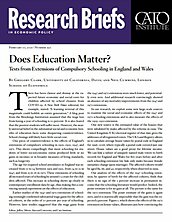One piece of counterevidence is the effects of England’s extensions of compulsory schooling in 1919–1922, 1947, and 1972. This shows compellingly that more schooling for students of lower socioeconomic status produced little or no gains in incomes or in broader measures of living standards, such as longevity.
The age for required school attendance in England was increased from 12 to 14 between 1919 and 1922, from 14 to 15 in 1947, and from 15 to 16 in 1972. These extensions of schooling all increased years of schooling by around 0.5 years for the children affected. This increase in schooling shows up clearly in contemporary enrollment data by age, thus making this a convincing natural experiment on the effects of education.
Earlier studies of the 1947 and 1972 extensions of schooling seemingly confirmed substantial wage gains for the affected cohorts, in the order of 10 percent per year of schooling. However, later studies suggested that the wage gains from the 1947 and 1972 extensions were much lower, and potentially even zero. And additional research convincingly showed an absence of any mortality improvements from the 1947 and 1972 extensions.
In our research, we exploit some new large-scale sources to examine the social and economic effects of the 1947 and 1972 schooling extensions and to also measure the effects of the 1919–1922 extension.
One new source is the estimated value of the houses that were inhabited by males affected by the reforms in 1999. The United Kingdom (UK) electoral register of that date gives the addresses of all registered voters. The UK Land Registry allows us to calculate average house values by postal code in England for 1996–2016, where typically a postal code covered just one street. House values are a good proxy for lifetime income. We can link a subset of uniquely named male voters to birth records for England and Wales for five years before and after each schooling extension (we link only males because female surnames change upon marriage). The affected cohorts would be aged 89, 66, and 42, respectively, when observed in 1999.
Our analysis of the effects of the 1947 schooling extension, by quarter of birth for the affected cohorts, finds that there is no sign of the 5 percent increase in permanent income that the schooling literature would predict. Indeed, the point estimate is for no gain at all. The picture is the same for the 1972 extension. The point estimate of the gains is again zero, and it is statistically impossible that the gain was the expected 5 percent. Figure 1, which shows the effects of the 1972 extension on house values, illustrates just how convincing the absence of gain from another 0.5 years of schooling is for the affected cohorts.

